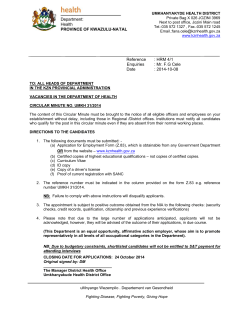
MULTI‐DRUG RESISTANT KLEBSIELLA PNEUMONIAE (MDR‐KP) PATIENT FACTSHEET
MULTI‐DRUG RESISTANT KLEBSIELLA PNEUMONIAE (MDR‐KP) PATIENT FACTSHEET What are multi‐drug resistant Klebsiella pneumoniae (MDR‐KP)? Klebsiella pneumoniae are just one of many different types of bugs (bacteria) that can live in the bowel. The word Enterobacteriaceae is sometimes used to refer to Klebsiella and a number of other similar bacteria (for example E. coli), because they are bacteria that live in the enteric tract, which is another term used to describe the bowel or gut. Multi‐drug resistant Klebsiella pneumoniae (MDR‐KP) are a type of Klebsiella pneumoniae which have become resistant to several different types of commonly used antibiotics. This means that those antibiotics may not be helpful for treating infection caused by MDR‐KP. Can MDR‐KP be harmful? For most patients, MDR‐KP live harmlessly in the bowel and do not cause infection. However, sometimes MDR‐ KP can cause infection, for example in a vulnerable patient who might be in the intensive care unit or receiving chemotherapy. MDR‐KP can cause infections, such as kidney infections, wound infections or in severe cases, blood infection. Antibiotics are needed to treat infection caused by MDR‐KP. If a patient is prone to infection and the infection is caused by MDR‐KP, it can be more difficult to treat, because many of the commonly used antibiotics will not work. Doctors need to know as soon as possible if a patient is carrying MDR‐KP, so that the most effective antibiotics can be chosen to treat the infection. How do people get MDR‐KP? Patients who have already taken lots of antibiotics are more at risk of picking up MDR‐KP. The reason for this is that the bugs are more exposed to antibiotics, and are therefore more likely to develop ‘resistance’ to that antibiotic, so that antibiotic no longer works. MDR‐KP can be carried by patients, healthcare staff or visitors, either harmlessly or if they have an MDR‐KP infection. MDR‐KP can spread between patients through direct contact with each other or by touching items or surfaces that the person with MDR‐KP may have touched, such as bed rails, toilets or equipment. As patients in hospital are much more vulnerable to infection than patients in their own homes, special precautions are required to prevent the spread of MDR‐KP between patients in hospital. MDRKP PATIENT FACTSHEET VERSION 1.0 HPSC IRELAND ‐ OCTOBER 2014 Page 1 What are the special precautions for patients with MDR‐KP? Special precautions have been designed to prevent MDR‐KP spreading between patients on the ward. In the hospital, if a patient has a positive test result for MDR‐KP, the patient may be cared for in an isolation room with his or her own toilet or commode. Although MDR‐KP live in the bowel they do not cause diarrhoea. However, if a person has diarrhoea for some other reason they can then be spread more easily. Staff should perform hand hygiene and wear gloves and aprons before coming into contact with a patient who is carrying MDR‐KP, to protect the patient from picking up any other bacteria and to protect the hands and clothes of the staff member. Patients, staff and visitors must pay special attention to hand hygiene. All staff must clean their hands before and after any contact with every patient, regardless of whether or not the patient has MDR‐KP. If visitors are helping out with a patient’s physical care, nursing staff will advise if extra precautions are required, such as wearing gloves and aprons. I have been diagnosed as carrying MDR‐KP, how can I help? If you go to the doctor, attend another clinic, hospital or nursing home; let them know you have had a positive MDR‐KP result. They can then take special precautions to stop MDR‐KP spreading to other patients who might be more prone to getting an infection. It might be convenient for you to keep a copy of this leaflet and show it to the staff if you find the name of the bacteria difficult to remember. What happens when a patient carrying MDR‐KP is ready to leave hospital? The patient can go home as soon it is decided that discharge home is appropriate, even if the patient is carrying MDR‐KP. Carrying MDR‐KP will not affect patient discharge. If a patient is going to another hospital or nursing home, the nurse or doctor will let the other hospital or nursing home know about the positive MDR‐KP result so that they can reduce the risk of it spreading to other patients. What happens when the patient carrying MDR‐KP goes home? There is no need to take special precautions at home. People in the community are usually fit and healthier so they are less likely than hospital patients to pick up MDR‐KP. Clothes, bed linen and dishes can be washed as usual. It is always very important to wash the hands carefully after using the toilet and before preparing meals or eating, to stop bugs spreading to other people. Clean hands protect us from lots of bacteria and viruses, not just MDR‐KP. Can the body get rid of MDR‐KP? The body may clear MDR‐KP from the bowel as recovery from illness takes place, but this is not always the case and it may remain in the bowel for some time. Taking antibiotics can encourage MDR‐KP to grow in the bowel again, so they should only be taken for a very good reason. Antibiotics are available to treat MDR‐KP infection but they probably will not clear MDR‐KP from the bowel. MDRKP PATIENT FACTSHEET VERSION 1.0 HPSC IRELAND ‐ OCTOBER 2014 Page 2
© Copyright 2025











